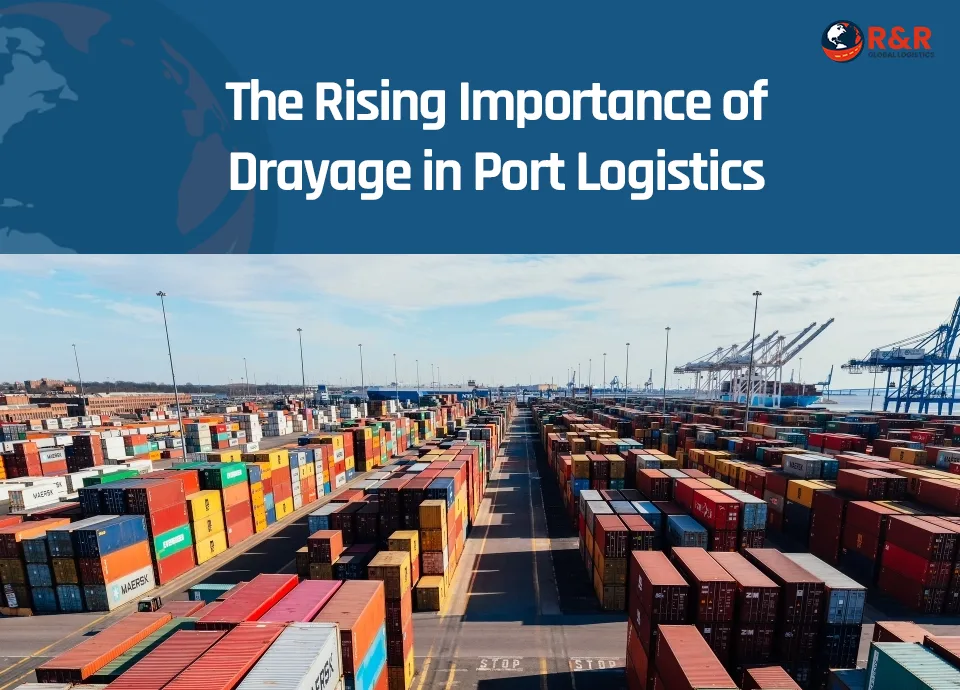Introduction: Drayage — A Small Word with Massive Supply Chain Impact
In the vast world of supply chain logistics, “drayage” might seem like a minor operation. But in reality, this short-distance transport service plays a massive role in keeping global trade flowing. Drayage connects sea ports to warehouses, rail yards, and distribution hubs — serving as the critical first and last mile of the container journey.
As global trade continues to accelerate and port congestion grows, drayage has become one of the most vital, and often underestimated, links in the logistics chain. Let’s dive into why drayage matters more than ever and how businesses can leverage it for more resilient, efficient operations.

What is Drayage and Why Does it Matter?
Drayage refers to the transport of shipping containers over short distances — typically from a port to a nearby warehouse, rail terminal, or distribution facility. While the journey might only cover 10 to 50 miles, its importance is immense.
Why?
Because if containers can’t be moved quickly out of port terminals, they cause bottlenecks, rack up demurrage fees, and disrupt the timing of inland deliveries. In today’s fast-paced world of just-in-time inventory and e-commerce, even minor port delays can ripple across the entire supply chain.
The Port Congestion Crisis and the Drayage Response
Over the last few years, major ports around the world — including Los Angeles, Long Beach, Houston, and Savannah — have faced unprecedented congestion. Labor shortages, equipment scarcities, and soaring import volumes mean containers are sitting longer at ports than ever before.
In response, drayage providers are stepping up with:
- 24/7 operations
- GPS-tracked vehicles
- Access to chassis and gensets
- TWIC-certified drivers for port access
- On-demand dispatch teams to avoid detention penalties
The rising importance of drayage lies in its ability to relieve congestion, reduce costs, and maintain velocity in a stressed supply chain.
E-Commerce, Speed, and the Last Mile Pressure
As online shopping surges, so does the need for fast delivery — and that starts at the port. Retailers and fulfillment centers rely heavily on efficient drayage to ensure that containerized goods move immediately from ship to shelf.
Modern drayage operations now act as the bridge between container ports and last-mile fulfillment, providing:
- Same-day container moves
- Real-time visibility for warehouse coordination
- Flexible transloading and cross-docking
- Short-term warehousing near ports
Drayage has evolved beyond mere port pickup — it’s now an integrated part of just-in-time distribution.
Environmental Pressure and Drayage Innovation
Drayage trucks, often diesel-powered and operating in dense urban areas, contribute significantly to port-related emissions. In response, regulatory bodies like the EPA and state governments are pushing for cleaner alternatives.
Forward-thinking drayage companies are embracing:
- Electric drayage trucks
- Low-emission routing
- Fleet modernization grants
- Strategic staging to reduce idle time
By focusing on sustainability, modern drayage is aligning with the growing ESG (Environmental, Social, Governance) priorities of today’s supply chains.
Technology is Transforming Drayage
Tech integration is one of the most exciting changes in port logistics. Traditional drayage involved a lot of manual coordination, paperwork, and guesswork. That’s no longer the case.
Leading drayage providers are using:
- Port scheduling systems and EDI connections
- Mobile apps for real-time communication with drivers
- Digital load boards and predictive ETAs
- Telematics for chassis availability and container status
This digital transformation makes drayage faster, smarter, and more transparent — crucial in today’s high-pressure logistics environment.
Strategic Warehousing and Transloading Synergy
One of the rising trends in drayage is strategic integration with warehousing and transloading. Companies that operate drayage services near transload hubs can offer seamless transfers between ocean containers and domestic trailers — saving time and cost.
This approach benefits shippers by:
- Reducing inland transportation delays
- Avoiding overweight container surcharges
- Allowing for product re-labeling, consolidation, or inspection
- Minimizing dwell times at destination DCs
Port-centric warehousing is no longer optional — it’s a competitive advantage.
Rising Challenges in Drayage — And How to Overcome Them
Drayage isn’t without its challenges. Key issues include:
- Driver shortages (especially those TWIC-certified for port entry)
- Chassis shortages
- Unpredictable port dwell times
- Increasing demurrage and detention charges
The best drayage partners mitigate these risks by:
- Maintaining in-house equipment and chassis
- Providing 24/7 dispatch support
- Investing in driver retention and training
- Offering automated appointment scheduling
Shippers looking to protect their supply chain should vet drayage providers not just on price, but on capacity, responsiveness, and technology stack.
Why Drayage Will Define the Next Era of Port Logistics
As the global logistics industry becomes faster, more fragmented, and increasingly tech-driven, drayage is evolving from a commodity service into a critical strategic function.
Whether you’re a small importer or a large enterprise shipper, the ability to move containers rapidly and cost-effectively from port to warehouse has a direct impact on:
- Customer satisfaction
- Inventory availability
- Operating costs
- Brand reputation
In short: the smarter your drayage, the stronger your supply chain.
Final Thoughts: Partnering for Port Efficiency
With drayage gaining such strategic importance, businesses can no longer afford to treat it as an afterthought. It’s time to think beyond the port gate and invest in partnerships that deliver consistency, visibility, and speed.
At R&R Global Logistics, we provide fully integrated drayage solutions designed for reliability, compliance, and performance. Whether it’s managing congestion, scaling storage, or ensuring fast container clearance — we’ve got you covered.
